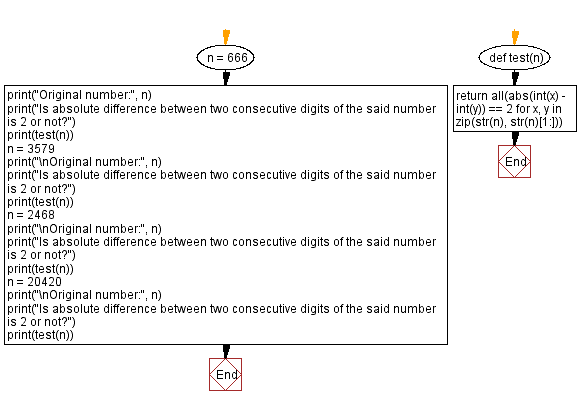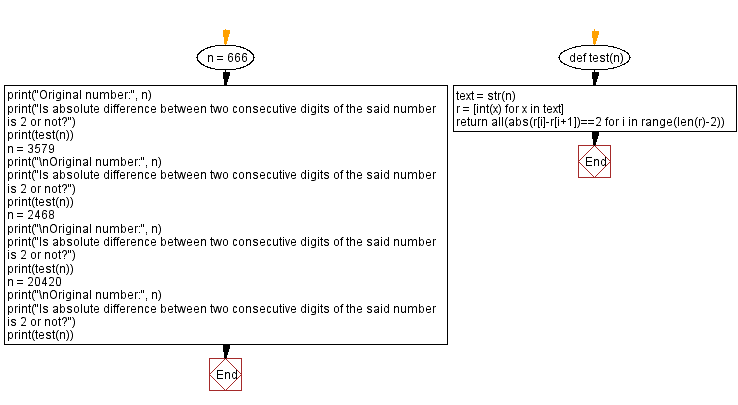Python Exercises: Absolute difference between two consecutive digits
92. Consecutive Digits Difference Checker
Write a Python program that checks whether the absolute difference between two consecutive digits is two or not. Return true otherwise false.
Sample Data:
(666) -> False
(3579) -> True
(2468) -> True
(20420) -> False
Sample Solution-1:
Python Code:
def test(n):
return all(abs(int(x) - int(y)) == 2 for x, y in zip(str(n), str(n)[1:]))
n = 666
print("Original number:", n)
print("Is absolute difference between two consecutive digits of the said number is 2 or not?")
print(test(n))
n = 3579
print("\nOriginal number:", n)
print("Is absolute difference between two consecutive digits of the said number is 2 or not?")
print(test(n))
n = 2468
print("\nOriginal number:", n)
print("Is absolute difference between two consecutive digits of the said number is 2 or not?")
print(test(n))
n = 20420
print("\nOriginal number:", n)
print("Is absolute difference between two consecutive digits of the said number is 2 or not?")
print(test(n))
Sample Output:
Original number: 666 Is absolute difference between two consecutive digits of the said number is 2 or not? False Original number: 3579 Is absolute difference between two consecutive digits of the said number is 2 or not? True Original number: 2468 Is absolute difference between two consecutive digits of the said number is 2 or not? True Original number: 20420 Is absolute difference between two consecutive digits of the said number is 2 or not? False
Flowchart:

Sample Solution-2:
Python Code:
def test(n):
text = str(n)
r = [int(x) for x in text]
return all(abs(r[i]-r[i+1])==2 for i in range(len(r)-2))
n = 666
print("Original number:", n)
print("Is absolute difference between two consecutive digits of the said number is 2 or not?")
print(test(n))
n = 3579
print("\nOriginal number:", n)
print("Is absolute difference between two consecutive digits of the said number is 2 or not?")
print(test(n))
n = 2468
print("\nOriginal number:", n)
print("Is absolute difference between two consecutive digits of the said number is 2 or not?")
print(test(n))
n = 20420
print("\nOriginal number:", n)
print("Is absolute difference between two consecutive digits of the said number is 2 or not?")
print(test(n))
Sample Output:
Original number: 666 Is absolute difference between two consecutive digits of the said number is 2 or not? False Original number: 3579 Is absolute difference between two consecutive digits of the said number is 2 or not? True Original number: 2468 Is absolute difference between two consecutive digits of the said number is 2 or not? True Original number: 20420 Is absolute difference between two consecutive digits of the said number is 2 or not? False
Flowchart:

For more Practice: Solve these Related Problems:
- Write a Python program to check if the absolute difference between every pair of consecutive digits in a number is exactly two, and print True or False.
- Write a Python function that iterates through the digits of an integer and returns True if the condition holds for all adjacent digits, otherwise False.
- Write a Python script to prompt for a number, compute the differences between consecutive digits, and output whether all differences equal two.
- Write a Python program to test multiple numbers for the consecutive digit difference condition and then display the results in a formatted report.
Go to:
Previous Python Exercise: Next number containing only distinct digits.
Next Python Exercise: Rearrange the digits of a number.
Python Code Editor:
Have another way to solve this solution? Contribute your code (and comments) through Disqus.
What is the difficulty level of this exercise?
Test your Programming skills with w3resource's quiz.
